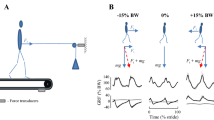Abstract
Prior work from mammals suggests that load experienced by extensor muscles of the hindlimbs (i.e. Duysens and Pearson 1980; Pearson and Collins 1993; Fouad and Pearson 1997) or cutaneous afferents from the plantar surface of the foot (Duysens and Pearson 1976; Guertin et al. 1995) enhances activity in extensor muscles during the stance phase, and delays the onset of flexor activity associated with the swing phase. The presumed functional significance of this phenomenon is that extensor activity of the supporting limb during walking can: (a) reinforce the supporting function in proportion to the load experienced, and (b) prolong the stance phase until unloading of the limb has occurred. Whether a similar functional role exists for load-sensitive afferents during walking in the human is unknown. In this study, the effect of adding or removing a substantial load (30% of body weight) at the centre of mass was studied in healthy adult human subjects. Loads were applied near the centre of mass to avoid the need for postural adjustments which might confound the interpretation of the results. Subjects walked on a treadmill with either: (a) a sustained increase or decrease in load, or (b) a sudden unexpected increase or decrease in load. In general, subjects responded to the changes in load by changing the amplitude of the extensor electromyographic (EMG) bursts. For example, with sudden unexpected additions in load, the average increase in amplitude was 40% for the soleus across the stance phase, and 134% for the quadriceps during the early part of the stance phase. Extensor EMGs increased with both sustained and sudden increases in load. Extensor EMG durations also increased (average increase in duration of 4% for soleus with sudden loading, and 7% for sustained loading). Cycle duration hardly changed (average increase of 0.5% with both sudden and sustained loading). These results differ from those of infants subjected to a similar perturbation during supported walking. A large change in timing (i.e. an increase in the duration of the stance phase by 30% and the step cycle by 28%) was seen in the infants, with no change in the amplitude of the EMG burst (Yang et al. 1998). These results suggest that the central nervous system can control the timing and amplitude of extensor EMG activity in response to loading independently. Maturation of the two components most likely occurs independently. In the adult, independent control of the two components may provide greater flexibility of the response.
Similar content being viewed by others
Author information
Authors and Affiliations
Additional information
Received: 28 April 1998 / Accepted: 3 September 1998
Rights and permissions
About this article
Cite this article
Stephens, M., Yang, J. Loading during the stance phase of walking in humans increases the extensor EMG amplitude but does not change the duration of the step cycle. Exp Brain Res 124, 363–370 (1999). https://doi.org/10.1007/s002210050633
Issue Date:
DOI: https://doi.org/10.1007/s002210050633




